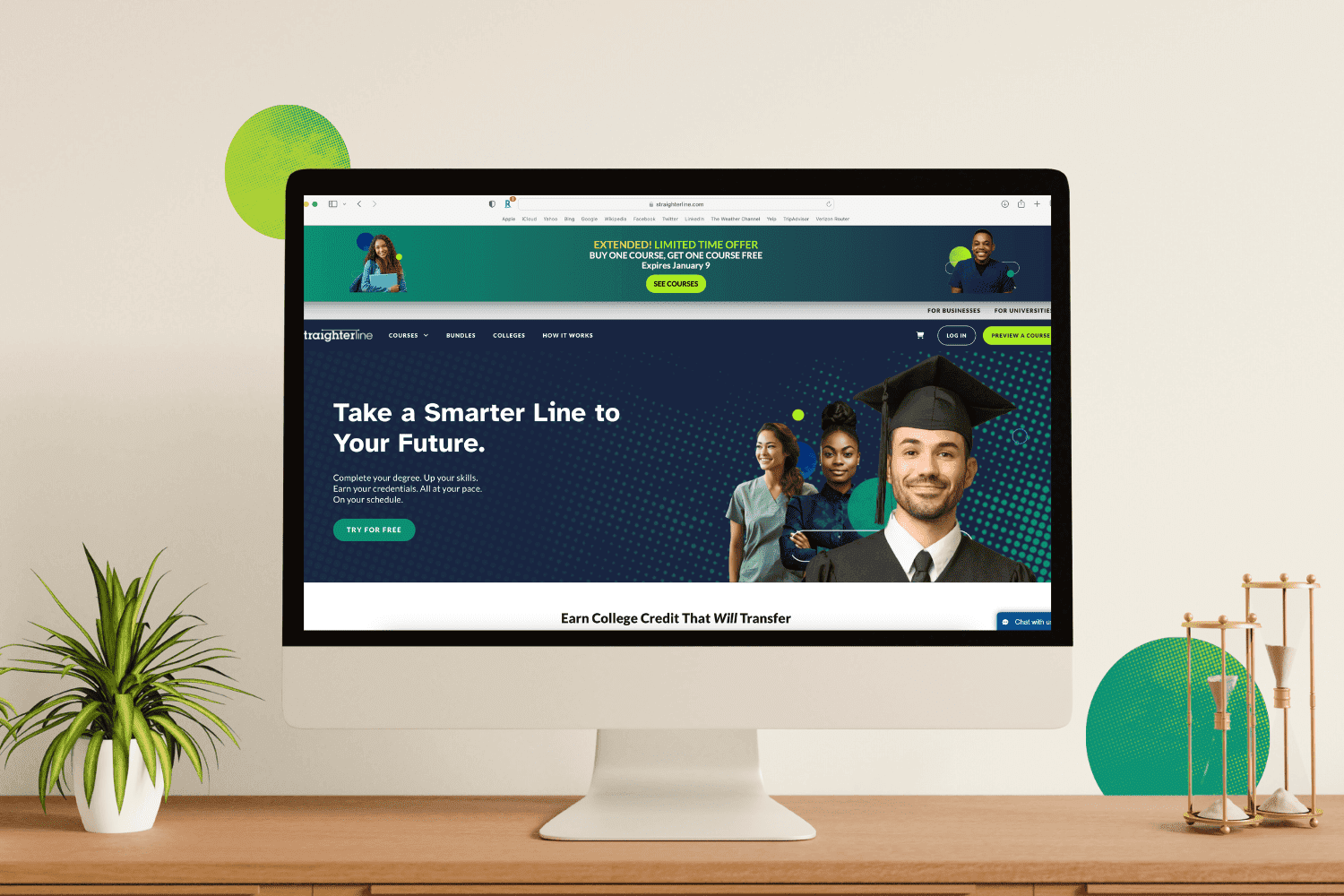Maximizing FAFSA benefits while transferring online credits earned through StraighterLine can be a game-changer for students looking for affordable education. Over 3,000 schools have accepted transfer credit from StraighterLine, including our 180+ partner schools that guarantee they’ll recognize your hard work and count your credits towards your degree — no questions asked. The potential for cost savings is huge when you take that into consideration.
Navigating the world of credit transfers and financial aid can seem complicated, but it's definitely worth it. By knowing how to combine FAFSA benefits with transferable online credits, you’ll be better set up to lower your overall education costs. We’ll walk you through the process, giving you tips and pointing out any challenges you’ll want to avoid.
Table of Contents
- Understand FAFSA and Online Credit Transfers
- What Is FAFSA?
- The Role of Online Credits in Higher Education
- Prepare for FAFSA While Taking Online Courses
- How to Maximize FAFSA Benefits for Online Students
- The Steps for Transferring Online Credits Effectively
- Balancing Online Credits and FAFSA Eligibility
- What You Need to Understand Credit Load Requirements
- Nail Your FAFSA Strategy and Save on Tuition
- Use StraighterLine to Maximize Your FAFSA Dollars
- Frequently Asked Questions About Maximizing FAFSA Benefits
Understand FAFSA and Online Credit Transfers
Being able to work through the intricacies between FAFSA benefits and online credit transfers can significantly lower your education costs. We’ll break down FAFSA and show you how online credits play a role in your higher education, helping you maximize your financial aid.
What Is FAFSA?
The Free Application for Federal Student Aid (FAFSA) is essential for students looking for financial support to cover college or grad school. The FAFSA form is your ticket to federal, state, and institutional aid, like grants, loans, and work-study programs. Here’s the deal:
FAFSA is run by the U.S. Department of Education
It determines your eligibility for different kinds of financial aid
You’ll need to meet a few criteria:
U.S. citizenship or eligible non-citizen status
A valid Social Security number
Enrollment or acceptance into an accredited degree or certificate program
Staying on track with your academic progress
No defaults on federal student loans or federal grants owed
Filling out the FAFSA is the most important step to getting the financial support you need, no matter your situation. It's the first move in crafting a solid financial plan for your education.
The Role of Online Credits in Higher Education
Online credits have shaken up the education game, giving students flexible and budget-friendly options. Here’s how they fit into your college journey:
Cost-effectiveness: Online courses typically cost less than in-person classes, so you can save on tuition
Flexibility: Learn at your own pace, on your schedule, while juggling work or other commitments
Transferability: Over 3,000 schools accept transferred online credits from StraighterLine, giving you tons of options to finish your degree
Accelerated learning: Finish courses faster, possibly speeding up your path to graduation
Diverse offerings: Access a wide range of courses and subjects that might not be available at your main school
When you combine online credits with FAFSA benefits, you create a smart strategy for minimizing education costs. Just make sure to communicate with your school to verify your online credits align with your degree requirements and will transfer as intended.
Prepare for FAFSA While Taking Online Courses
Preparing your FAFSA while you’re taking online courses takes careful planning and attention to detail. Here’s how you can maximize your financial aid while studying online.
Gather Your Financial Documents
To make the FAFSA process run smoothly, gather these key documents:
Tax returns (yours and your parents', if applicable)
W-2 forms and other income records
Bank statements
Investment account statements
Records of untaxed income (like child support or interest income)
Social Security numbers for you and your parents
Driver’s license (if you have one)
Alien registration number (if you're a non-U.S. citizen)
Having all of these on hand will help you breeze through the application without delays. Remember, accuracy is crucial when reporting financial information on your FAFSA application.
Time Your FAFSA Application
Timing is everything when it comes to FAFSA:
Submit early: FAFSA opens October 1st every year, so get your application in ASAP to boost your chances of getting more aid.
Know your deadlines:
Federal deadline: June 30th
State deadlines: Vary by state (often earlier than federal)
School deadlines: Some are as early as February
Sync with your course schedule: Make sure your FAFSA application lines up with your online course dates to keep your aid rolling in.
Update regularly: If your finances change, update your FAFSA to reflect that.
Renew annually: Set reminders to reapply each year you’re in school to maintain your aid eligibility.
By getting your FAFSA in early and syncing it with your online courses, you’ll be in the best spot to get the financial aid you need and save as much money as possible.
How to Maximize FAFSA Benefits for Online Students
Getting the most out of FAFSA as an online student means staying organized and paying attention to both your academic and financial standing. Here’s how to make it work.
Maintain Satisfactory Academic Progress (SAP)
Staying eligible for FAFSA means keeping up with your academic progress. Here's what you need to do:
Maintain a minimum GPA (typically 2.0 for undergrads)
Complete at least 67% of attempted credits
Finish your degree within 150% of the program length
Online students should:
Create a study schedule to stay on track
Use the academic resources your school offers
Stay in touch with your professors
Monitor your grades and credit completion
If you’re falling behind, get help early. Most schools have online tutoring or support services. Staying on top of SAP standards ensures your financial aid continues.
Tips for Leveraging Part-Time Enrollment
Part-time enrollment can work in your favor as an online student:
Smaller course loads can help with work-life balance
Lower tuition costs each semester
Extended eligibility for certain aid programs
But keep in mind:
Some grants need full-time enrollment
Part-time status may reduce your total aid
It could take longer to graduate
To make the most of part-time status:
Talk to your financial aid office about how it affects your aid
Plan your course load carefully to maintain at least half-time status (usually 6 credits)
Balance work, life, and study commitments carefully
The Steps for Transferring Online Credits Effectively
Strategically transferring online credits can help you save money and get the most out of your FAFSA benefits. These are the steps you can take to make sure your online credits are recognized and applied towards your degree program.
Research Transfer-Friendly Schools
When looking to transfer credits, finding the right schools is key:
Check articulation agreements: Look for schools with partnerships that make credit transfers easier
Review transfer policies: Make sure the schools you're interested in have flexible credit transfer policies
Use credit transfer calculators: Many schools have tools to help you see how your credits will transfer
Talk to admissions counselors: They can guide you through the credit transfer process
Prioritize schools with generous transfer policies: Look for schools known for accepting a high percentage of transfer credits and prioritize these schools in your research
Ensure Course Equivalency
To maximize the transfer of online credits, it’s important to ensure course equivalency and verify accreditation. Here’s how to approach this:
Verify accreditation: Make sure both your current and prospective schools are accredited. Accreditation is vital for credit transfer and FAFSA eligibility
Compare course descriptions: Check that your online courses match the ones at your school by reviewing the content, learning outcomes, and credit hours
Obtain course syllabi: These help admission officers evaluate course equivalencies more accurately
Use articulation databases: Some states have online resources to show how credits transfer between institutions
Consider prior learning assessments: Some schools offer assessments to evaluate knowledge gained through online courses, potentially granting additional credits
By focusing on course equivalency and accreditation, you’ll maximize your transferable credits and keep moving toward your degree while optimizing your FAFSA benefits.
Balancing Online Credits and FAFSA Eligibility
Balancing online credits with FAFSA eligibility takes some planning and an understanding of credit load requirements. We’ll explore the key factors to keep in mind when transferring online credits while getting the most out of your FAFSA benefits.
What You Need to Understand Credit Load Requirements
To stay eligible for FAFSA while transferring online credits, you need to meet minimum enrollment standards. Here's what to keep in mind:
Full-time status: Typically 12+ credit hours per semester
Part-time status: Usually 6-11 credit hours per semester
Minimum for aid: Most federal aid requires at least half-time enrollment
School-specific rules: Some schools have their own credit load requirements
Program type: Graduate programs often have different credit hour standards
Aid type variations: Certain grants or scholarships may have specific credit minimums
Dropping below half-time status can impact your aid eligibility and even affect loan repayment terms. Always check with your school’s financial aid office before making changes to your course load.
Avoid Common Pitfalls in Credit Transfer
Transferring online credits can sometimes throw a wrench in your FAFSA benefits. Here's how to sidestep the common issues:
Accreditation mismatch: Make sure your school of choice is accredited by recognized agencies and that your online course provider is recommended for college credit (such as how StraighterLine is recommend by the American Council on Education)
Credit equivalency issues: Verify course equivalencies with your school to ensure the credits will transfer as intended.
Time limits on credits: Some schools may not accept credits that they deem to be too old.
Grade requirements: Most schools require a minimum grade (usually a C or better) for credit transfer.
Residency requirements: Keep track of the minimum credits you need to take at your school.
Major-specific limitations: Some programs have limits on how many credits you can transfer.
Maximum transfer limits: Schools often cap the number of credits you can transfer.
To avoid these headaches, speak with school’s admissions and financial aid offices. Get everything in writing about which credits will transfer and how they apply to your degree.
Strategies for Optimizing FAFSA Benefits
Maximizing your FAFSA benefits while transferring online credits comes down to smart strategies. Let’s take a look at additional financial aid options and the importance of keeping communication open with financial aid offices.
Explore Additional Financial Aid Options
Don’t stop at FAFSA — there are other ways to fund your education. Consider these additional financial aid option:
Institutional scholarships: Many colleges offer scholarships just for transfer students
Private scholarships: Look into external organizations that provide scholarships for your field
State grants: Check with your state’s education department for grants
Work-study programs: These can give you experience and extra income while you study
Employer tuition assistance: If you're working, ask your employer about tuition reimbursement programs
Remember to update your FAFSA when you transfer so your financial aid goes to the right place. The new FAFSA uses the Student Aid Index (SAI) instead of the Expected Family Contribution (EFC) to determine Pell Grant eligibility and other need-based aid.
Communicate with Financial Aid Offices
Connecting with financial aid offices is key to maximizing your aid. Here’s how to approach it:
Schedule appointments: Meet with the financial aid office at your school to get any questions you may have answered directly
Prepare questions: Write down specific questions about how transferring credits affects your financial aid
Provide documentation: Bring all your financial documents and transcripts to the meetings
Understand deadlines: Confirm deadlines for scholarships and other aid at your new school
Follow up: After your meetings, send thank-you emails and recap the main points you discussed
Under the new FAFSA, "Contributors" (parents or step-parents) must give their consent for the IRS to directly transfer Federal Tax Information from the IRS. Make sure all Contributors are on board with this process to keep your FAFSA eligibility on track.
Nail Your FAFSA Strategy and Save on Tuition
Maximizing FAFSA benefits while transferring online credits is a smart way to save on education costs. By understanding how to navigate financial aid, staying on top of your academic progress, and carefully planning your credit transfers, you can create the most cost-effective path to your degree.
Remember to stay proactive: keep your FAFSA updated, explore additional aid options, and communicate regularly with financial aid offices. With the right approach, you’ll be set to make the most of your educational journey while keeping costs low.
Use StraighterLine to Maximize Your FAFSA Dollars
StraighterLine is the leading online college course provider offering prereq and gen ed courses at a fraction of the price you’ll pay at your school. That means you can take your courses online and at your own pace, transfer the credits you earn with us to your school, and save your FAFSA financial aid dollars to use to pay for your upper level courses.
Browse through the 75+ courses we offer to see to find the ones you can transfer towards your degree while saving thousands on tuition.
Frequently Asked Questions About Maximizing FAFSA Benefits
How do my assets affect my FAFSA eligibility for need-based financial aid?
Answer: The FAFSA considers both student and parent assets when determining eligibility for need-based financial aid. Reportable assets, such as cash savings and certain investments, can impact the financial aid formula used by the federal government. It’s essential to understand that while the FAFSA process evaluates parental assets, certain assets may not be reportable, such as your primary residence or retirement accounts. Consulting a financial planner can help you strategize on how to manage your assets effectively without jeopardizing your financial aid eligibility.
What is the significance of a college savings plan when applying for federal financial aid?
Answer: A college savings plan can be a valuable tool for managing your educational expenses. However, the funds in these plans are considered reportable assets on your FAFSA. This can affect your overall financial aid package since the federal government includes these balances in the financial aid calculation. It's crucial to plan your contributions carefully and discuss potential impacts with a financial planner to maximize your aid eligibility without negatively impacting your overall cost of college.
How can timing my FAFSA application on a first-come, first-served basis benefit me?
Answer: Completing your FAFSA application early can significantly influence your chances of receiving financial aid, particularly for need-based awards that may be distributed on a first-come, first-served basis. Early applicants are more likely to receive aid when funds are more readily available, as many financial aid sources have limited budgets. Additionally, applying early allows you to better assess your need-based financial aid options, resulting in a clearer understanding of the total costs associated with your college education.












